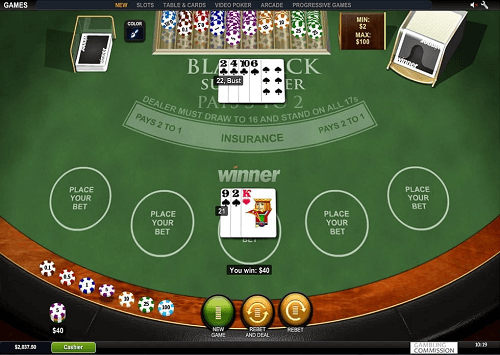Sylvia Key | September 21, 2023 | Updated on: January 12th, 2024

Play Real Money Blackjack Online
AU$10000 Bonus
+ 200 Free Spins
99% Payout
Rating: 4/5
99% Payout
Min Deposit: AU$10
AU$3000 Bonus
+ 100 Free Spins
98% Payout
Rating: 5/5
98% Payout
Min Deposit: AU$20
AU$5500 Bonus
+ 125 Free Spins
99% Payout
Rating: 5/5
99% Payout
Min Deposit: AU$10
AU$6750 Bonus
+ 250 Free Spins
98% Payout
Rating: 4/5
98% Payout
Min Deposit: AU$30
AU$1850 Bonus
+ 500 Free Spins
98% Payout
Rating: 4/5
97% Payout
Min Deposit: AU$10
AU$2000 Bonus
+ 200 Free Spins
97% Payout
Rating: 4/5
97% Payout
Min Deposit: AU$20
AU$750 Bonus
+ 200 Free Spins
98% Payout
Rating: 3/5
98% Payout
Min Deposit: AU$20
AU$2500 Bonus
+ 250 Free Spins
98% Payout
Rating: 4/5
98% Payout
Min Deposit: AU$10
AU$6000 Bonus
+ 250 Free Spins
98% Payout
Rating: 5/5
98% Payout
Min Deposit: AU$15
AU$3000 Bonus
+ 300 Free Spins
98% Payout
Rating: 4/5
98% Payout
Min Deposit: AU$20
AU$2000 Bonus
+ 200 Free Spins
98% Payout
Rating: 4/5
98% Payout
Min Deposit: AU$10
AU$5000 Bonus
+ 75 Free Spins
99% Payout
Rating: 4.7/5
99% Payout
Min Deposit: AU$10
AU$7500 Bonus
+ 350 Free Spins
98% Payout
Rating: 5/5
98% Payout
Min Deposit: AU$30
AU$1670 Bonus
+ 600 Free Spins
98% Payout
Rating: 4.7/5
98% Payout
Min Deposit: AU$20
AU$7500 Bonus
+ 100 Free Spins
99% Payout
Rating: 5/5
99% Payout
Min Deposit: AU$20
AU$5000 Bonus
+ 300 Free Spins
98% Payout
Rating: 3/5
98% Payout
Min Deposit: AU$30
AU$4000 Bonus
+ 400 Free Spins
98% Payout
Rating: 3/5
Code: SKY125
Min Deposit: AU$30
AU$5000 Bonus
+ 300 Free Spins
98% Payout
Rating: 3/5
98% Payout
Min Deposit: AU$30
AU$3000 Bonus
+ 200 Free Spins
98% Payout
Rating: 3/5
98% Payout
Min Deposit: AU$20
AU$3000 Bonus
+ 225 Free Spins
98% Payout
Rating: 3/5
98% Payout
Min Deposit: AU$30
AU$750 Bonus
+ 100 Free Spins
98% Payout
Rating: 3/5
98% Payout
Min Deposit: AU$20
AU$4000 Bonus
+ 300 Free Spins
98% Payout
Rating: 4.7/5
98% Payout
Min Deposit: AU$30
AU$2500 Bonus
97% Payout
Rating: 4.8/5
98% Payout
Min Deposit: AU$25
AU$7000 Bonus
+ 200 Free Spins
98% Payout
Rating: 3/5
98% Payout
Min Deposit: AU$25
AU$3000 Bonus
+ 200 Free Spins
98% Payout
Rating: 3/5
98% Payout
Min Deposit: AU$30
AU$900 Bonus
+ 250 Free Spins
98% Payout
Rating: 4.7/5
98% Payout
Min Deposit: AU$15
AU$10000 Bonus
+ 200 Free Spins
98% Payout
Rating: 3/5
98% Payout
Min Deposit: AU$20
AU$750 Bonus
+ 200 Free Spins
98% Payout
Rating: 4/5
98% Payout
Min Deposit: AU$30
AU$8000 Bonus
+ 700 Free Spins
99% Payout
Rating: 3/5
99% Payout
Min Deposit: AU$30
AU$6000 Bonus
+ 200 Free Spins
99% Payout
Rating: 4.9/5
99% Payout
Min Deposit: AU$10
AU$1200 Bonus
+ 300 Free Spins
98% Payout
Rating: 3/5
98% Payout
Min Deposit: AU$15
AU$750 Bonus
+ 200 Free Spins
98% Payout
Rating: 4/5
98% Payout
Min Deposit: AU$15
AU$10,000 Bonus
+ 100 Free Spins
98% Payout
Rating: 3/5
98% Payout
Min Deposit: AU$30
AU$4000 Bonus
+ 150 Free Spins
99% Payout
Rating: 3/5
98% Payout
Min Deposit: AU$30
AU$750 Bonus
+ 200 Free Spins
98% Payout
Rating: 3/5
98% Payout
Min Deposit: AU$30
AU$7000 Bonus
+ 250 Free Spins
97% Payout
Rating: 3/5
97% Payout
Min Deposit: AU$10
AU$7500 Bonus
+ 550 Free Spins
98% Payout
Rating: 4.8/5
98% Payout
Min Deposit: AU$30
AU$6000 Bonus
+ 200 Free Spins
97% Payout
Rating: 3/5
97% Payout
Min Deposit: AU$10
AU$4000 Bonus
+ 475 Free Spins
98% Payout
Rating: 5/5
98% Payout
Min Deposit: AU$30
AU$10000 Bonus
+ 100 Free Spins
98% Payout
Rating: 4/5
98% Payout
Min Deposit: AU$30
AU$3000 Bonus
+ 200 Free Spins
98% Payout
Rating: 3/5
98% Payout
Min Deposit: AU$20
AU$4500 Bonus
+ 225 Free Spins
98% Payout
Rating: 3/5
98% Payout
Min Deposit: AU$30
AU$10000 Bonus
+ 500 Free Spins
98% Payout
Rating: 3/5
98% Payout
Min Deposit: AU$30
AU$10,000 Bonus
+ 100 Free Spins
99% Payout
Rating: 3/5
99% Payout
Min Deposit: AU$30
AU$5000 Bonus
+ 100 Free Spins
98% Payout
Rating: 3/5
98% Payout
Min Deposit: AU$20
AU$500 Bonus
+ 100 Free Spins
98% Payout
Rating: 5/5
98% Payout
Min Deposit: AU$25
AU$1500 Bonus
+ 500 Free Spins
98% Payout
Rating: 3/5
98% Payout
Min Deposit: AU$20
AU$2500 Bonus
+ 250 Free Spins
98% Payout
Rating: 3/5
98% Payout
Min Deposit: AU$20
AU$10,000 Bonus
+ 100 Free Spins
98% Payout
Rating: 3/5
98% Payout
Min Deposit: AU$20
AU$1500 Bonus
+ 100 Free Spins
99% Payout
Rating: 3/5
99% Payout
Min Deposit: AU$20
AU$4000 Bonus
+ 150 Free Spins
98% Payout
Rating: 3/5
98% Payout
Min Deposit: AU$20
AU$9000 Bonus
+ 200 Free Spins
97% Payout
Rating: 3/5
97% Payout
Min Deposit: AU$10
160% Bonus
+ 40 Free Spins
98% Payout
Rating: 4/5
98% Payout
Min Deposit: AU$20
AU$10,000 Bonus
+ 200 Free Spins
98% Payout
Rating: 3/5
98% Payout
Min Deposit: AU$30
AU$1500 Bonus
+ 200 Free Spins
98% Payout
Rating: 3/5
98% Payout
Min Deposit: AU$30
AU$7500 Bonus
+ 110 Free Spins
98% Payout
Rating: 3/5
98% Payout
Min Deposit: AU$10
250% Bonus
+ 50 Free Spins
98% Payout
Rating: 4/5
98% Payout
Min Deposit: AU$20
AU$1000 Bonus
+ 100 Free Spins
98% Payout
Rating: 3/5
98% Payout
Min Deposit: AU$10
AU$10000 Bonus
+ 200 Free Spins
98% Payout
Rating: 3/5
98% Payout
Min Deposit: AU$20
AU$1650 Bonus
+ 250 Free Spins
98% Payout
Rating: 3/5
98% Payout
Min Deposit: AU$20
AU$3,000 Bonus
+ 350 Free Spins
98% Payout
Rating: 3/5
98% Payout
Min Deposit: AU$30
AU$8000 Bonus
+ 250 Free Spins
98% Payout
Rating: 3/5
98% Payout
Min Deposit: AU$20
$600 Bonus
+ Free Spins
98% Payout
Rating: 3/5
98% Payout
Min Deposit: AU$
AU$5000 Bonus
+ 300 Free Spins
99% Payout
Rating: 3/5
99% Payout
Min Deposit: AU$10
AU$1250 Bonus
+ 75 Free Spins
98% Payout
Rating: 3/5
98% Payout
Min Deposit: AU$20
AU$500 Bonus
+ 100 Free Spins
98% Payout
Rating: 3/5
98% Payout
Min Deposit: AU$15
AU$1200 Bonus
+ 75 Free Spins
99% Payout
Rating: 3/5
99% Payout
Min Deposit: AU$10
AU$30,450 Bonus
+ 100 Free Spins
98% Payout
Rating: 3/5
98% Payout
Min Deposit: AU$20
AU$5000 Bonus
+ 100 Free Spins
97.6% Payout
Rating: 3/5
97.6% Payout
Min Deposit: AU$20
AU$4500 Bonus
+ 225 Free Spins
98% Payout
Rating: 3/5
98% Payout
Min Deposit: AU$30
AU$10000 Bonus
+ 150 Free Spins
99% Payout
Rating: 4/5
98% Payout
Min Deposit: AU$30
AU$1,200 Bonus
0 Free Spins
98% Payout
Rating: 3/5
98% Payout
Min Deposit: AU$26
AU$3000 Bonus
100 Free Spins
98% Payout
Rating: 3/5
98% Payout
Min Deposit: AU$15
AU$1000 Bonus
0 Free Spins
96% Payout
Rating: 3/5
96% Payout
Min Deposit: AU$26
AU$1,077 Bonus
0 Free Spins
97% Payout
Rating: 4/5
97% Payout
Min Deposit: AU$26
AU$1000 Bonus
0 Free Spins
97% Payout
Rating: 4/5
97% Payout
Min Deposit: AU$26
AU$800 Bonus
0 Free Spins
95% Payout
Rating: 3/5
95% Payout
Min Deposit: AU$26
AU$1500 Bonus
0 Free Spins
96% Payout
Rating: 3.5/5
96% Payout
Min Deposit: AU$26
AU$2500 Bonus
+ 200 Free Spins
98% Payout
Rating: 3/5
98% Payout
Min Deposit: AU$15
AU$1000 Bonus
+ 100 Free Spins
98% Payout
Rating: 5/5
98% Payout
Min Deposit: AU$20
AU$1500 Bonus
+ 25 Free Spins
98% Payout
Rating: 4.8/5
98% Payout
Min Deposit: AU$20
AU$1,500 Bonus
$5 Casino Bonus
96% Payout
Rating: 4/5
96% Payout
Min Deposit: AU$25
AU$1,500 Bonus
$25 Bingo Bonus
95% Payout
Rating: 3/5
95% Payout
Min Deposit: AU$25
AU$1000 Bonus
+ 250 Free Spins
99% Payout
Rating: 3/5
99% Payout
Min Deposit: AU$20
AU$2000 Bonus
+ 90 Free Spins
98% Payout
Rating: 4/5
98% Payout
Min Deposit: AU$20
AU$3000 Bonus
+ 100 Free Spins
97% Payout
Rating: 3/5
97% Payout
Min Deposit: AU$20
AU$15000 Bonus
+ 225 Free Spins
98% Payout
Rating: 3/5
98% Payout
Min Deposit: AU$20
AU$2000 Bonus
+ 200 Free Spins
97% Payout
Rating: 4.7/5
98% Payout
Min Deposit: AU$10
300% Bonus
+ 250 Free Spins
98% Payout
Rating: 3/5
98% Payout
Min Deposit: AU$10
AU$38000 Bonus
+ 300 Free Spins
98% Payout
Rating: 4.8/5
98% Payout
Min Deposit: 0.0001 BTC
AU$1500 Bonus
+ 200 Free Spins
97% Payout
Rating: 3/5
97% Payout
Min Deposit: AU$15
AU$4000 Bonus
+ 100 Free Spins
97% Payout
Rating: 4.8/5
97% Payout
Min Deposit: AU$10
AU$1200 Bonus
+ 50 Free Spins
98% Payout
Rating: 4.7/5
97% Payout
Min Deposit: AU$10
AU$2000 Bonus
+ 100 Free Spins
98% Payout
Rating: 4/5
98% Payout
Min Deposit: AU$15
AU$7777 Bonus
98% Payout
Rating: 4.7/5
98% Payout
Min Deposit: AU$10
AU$5000 Bonus
96% Payout
Rating: 4.5/5
98% Payout
Min Deposit: AU$20
AU$3000 Bonus
96% Payout
Rating: 3/5
96% Payout
Min Deposit: AU$20
AU$4000 Bonus
+ 300 Free Spins
98% Payout
Rating: 4.5/5
98% Payout
Min Deposit: AU$15
AU$800 Bonus
+ 120 Free Spins
98% Payout
Rating: 4.8/5
98% Payout
Min Deposit: AU$20
AU$8888 Bonus
+ 350 Free Spins
97% Payout
Rating: 4.8/5
97% Payout
Min Deposit: AU$20
AU$2500 Bonus
+ 500 Free Spins
97% Payout
Rating: 4.8/5
97% Payout
Min Deposit: AU$20
AU$675 Bonus
+ 250 Free Spins
97% Payout
Rating: 3/5
97% Payout
Min Deposit: AU$20
750% Bonus
+ 110 Free Spins
97% Payout
Rating: 4.8/5
97% Payout
Min Deposit: AU$20
AU$750 Bonus
+ 110 Free Spins
97% Payout
Rating: 4.8/5
97% Payout
Min Deposit: AU$20
AU$750 Bonus
+ 110 Free Spins
98% Payout
Rating: 4.8/5
98% Payout
Min Deposit: AU$25
AU$7500 Bonus
+ 100 Free Spins
98% Payout
Rating: 3/5
98% Payout
Min Deposit: AU$30
AU$3000 Bonus
+ 350 Free Spins
97% Payout
Rating: 3/5
97% Payout
Min Deposit: AU$30
AU$12500 Bonus
+ 55 Free Spins
97% Payout
Rating: 3/5
97% Payout
Min Deposit: AU$30
What is Online Blackjack Surrender?
You can discern a lot about an individual’s character by observing their behaviour at an online casino, especially in the game of blackjack. There are three distinct personality types that often surface based on their playing style.
- Firstly, there are the cautious players who prefer to stand or opt for surrender whenever the opportunity arises. In blackjack, surrendering means choosing to discard your cards instead of continuing to play or standing. This decision results in forfeiting half of your wager, and you await the next hand.
- Secondly, there are the innate risk-takers. These individuals who are always inclined to request one more card, even with a moderately decent hand, especially if the dealer appears vulnerable. They believe that an extra card might bring them closer to the coveted 21.
- Lastly, there are the studious players, those who possess a solid understanding of blackjack strategy and apply it diligently. They make calculated decisions, such as taking additional cards, standing, or choosing to surrender. This is based on the evolving dynamics of the hand.
Interestingly, both the conservative and adventurous players unknowingly fail to reduce the house edge in blackjack. In fact, their actions often decrease their chances of winning. Only by adhering to the basic blackjack strategy can one make informed choices regarding when to utilize blackjack surrender or request another card.
Online Blackjack Surrender Rules
Locating blackjack tables with surrender rules can be a rare find, whether in physical or online casinos. Yet, if you do come across one, understanding when to employ surrender versus playing or standing is paramount.
Steer clear of recklessly seeking extra cards without thought for the potential outcomes. Likewise, avoid being an overly cautious player who surrenders or stands too frequently.
Go for a wise, long-term strategy instead. This approach can significantly diminish the house edge and increase your chances of success over your gaming sessions.


How Blackjack Surrender Works
Blackjack surrender is a valuable option available in certain variants of the popular card game. It offers players a unique way to mitigate losses when facing challenging situations at the blackjack table.
Early Surrender Blackjack
Online gambling platforms offer a variety of blackjack games, each featuring distinct rules. These rules encompass factors such as the number of decks in play, dealer requirements (e.g., standing on soft 17), and the availability of surrender options. It’s important to note that there are two main types of surrender in blackjack: early surrender and late surrender.
In early surrender blackjack, players have the choice to discard their cards when the dealer reveals an ace or a ten, before confirming if the dealer has blackjack. While early surrender may appear advantageous, it’s relatively rare due to its impact on the player’s return.
It improves the player’s odds by approximately 0.39% against an ace and 0.24% against a ten. However, the catch lies in the other rules governing the table. Casinos often counterbalance this player advantage by implementing rules like allowing the dealer to draw another card on soft 17.
Furthermore, making an early surrender decision should be based on the specific scenario. When the dealer displays an ace, it’s typically advisable to surrender only if your hand holds limited potential, such as:
- Hard totals between 5 and 7
- Hard totals ranging from 12 to 17
- Pairs of 3s, 6s, 7s, or 8s
When the dealer reveals a ten, opting for early surrender is typically recommended if your hand consists of:
- Hard totals between 14 and 16
- Pairs of 7s and 8s (though only 8s in single-deck versions of blackjack)
In essence, while early surrender may seem like a promising way to enhance your returns, it’s essential to consider the overall table rules and evaluate your hand’s potential before making this decision.
Late Surrender in Blackjack
In the game of late surrender blackjack, players have the option to surrender their hand, but this choice comes after the dealer verifies for blackjack, typically when the dealer reveals a ten or an ace. If the dealer lacks a blackjack, you can opt to forfeit your hand and reclaim half of your original bet, preserving a portion of your initial wager.
Late surrender proves to be a strategic manoeuvre worth considering, primarily when you find yourself with a hand totalling 14, 15, or 16. However, it’s crucial to bear in mind that there are nuanced exceptions to this strategy, influenced by variables such as the number of decks in play and whether the dealer hits on a soft 17.
These exceptions can affect the optimal timing for employing late surrender, emphasizing the importance of familiarizing yourself with the precise rules of the blackjack variant you’re engaged in.
Surrender in Blackjack Gameplay
Surrender is an optional rule found in the classic blackjack game, available in both traditional brick-and-mortar casinos and online gambling platforms offering a diverse range of table games. This rule offers three variations: late surrender, early surrender against a dealer’s 10, and full Blackjack early surrender.
The degree to which this rule is permitted in your selected blackjack game can significantly influence your overall chances of success. Rule variations also play a pivotal role in shaping the fundamental strategy for playing hard hands and making split decisions, particularly in games where the dealer hits on a soft 17 hand.
For a more precise assessment of when to contemplate surrender, players can explore the composition-dependent approach. By delving into the intricacies of this approach, players can make more enlightened decisions regarding when to employ surrender as a strategic tactic.
This understanding empowers British players to pinpoint the optimal moments for surrendering in blackjack and execute this manoeuvre accurately when the situation calls for it
Blackjack Surrender FAQs
Is surrender a good bet in blackjack?
In summary, it is advisable to surrender whenever the odds are strongly unfavourable. On the contrary, you should avoid surrendering when dealt a pair of eights. In such a scenario, it is more advantageous to split them into two separate hands, increasing your chances of a favorable outcome as you continue to play
Can you surrender in online blackjack?
Besides early surrender, players can choose to abandon their hand for half of their original bet once the dealer exposes their cards.
This surrender choice remains open as long as the dealer does not hold a natural blackjack. However, if the dealer reaches a total of 21, the option to surrender becomes unavailable.
Should you hit stand or surrender in blackjack?
When your hand totals nine or less or falls within the 12-16 range, the best course of action is to take another card (hit). Conversely, when your hand reaches 17 or more, it is advisable to stop and not request additional cards (stand).
When the dealer’s face-up card is a four, five, or six, it becomes vital to avoid exceeding your target total. As a common practice, players tend to request another card (hit) when their hand totals eight or less, but they choose to stop and not draw more cards (stand) when their total reaches 12 or higher.
Can you surrender after splitting?
Once players have initiated a split, doubled down, or taken additional cards by hitting, they will no longer have the option to surrender.





























































































































